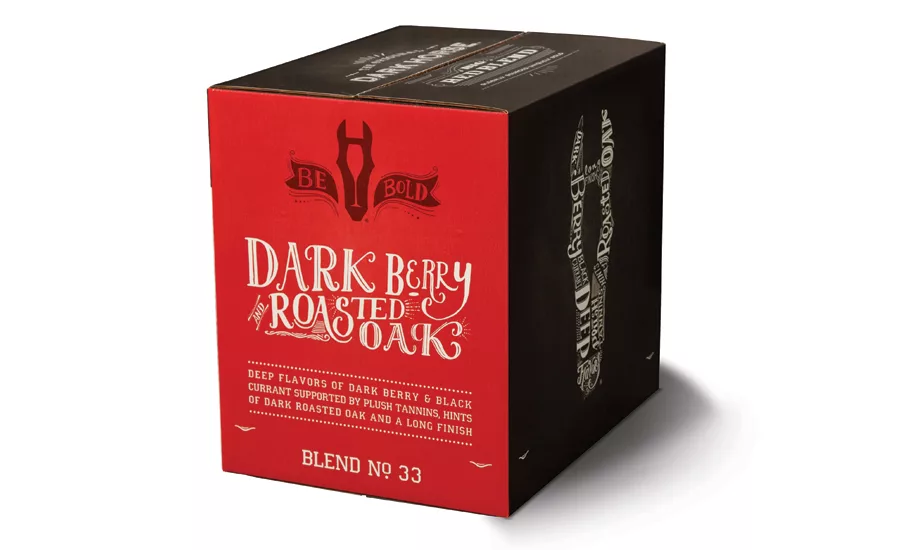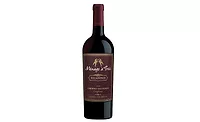Dark Horse Wines offer premium taste at value price
Wine brand utilize Georgia-Pacific packaging for shippers


A term originally associated with horse racing, dark horse has been used to describe not only relatively unknown race horses but also political candidates, award show nominees and even the songwriting and vocal skills of George Harrison in comparison to other members of The Beatles. Similar to these groups, one wine brand is embracing this mentality as it seeks to deliver high-quality wine at an affordable price to consumers.
Dark Horse Wine, a brand of Modesto, Calif.-based E. & J. Gallo Winery, began in test markets in a single lead retailer in the United States, but emerged on the national scene in the first quarter of 2015. In that year, the brand has resonated with retailers and consumers because of its premium taste profile and approachable price tag.
“Since national distribution last Q1, we are the No. 1 growth brand in the entire wine industry,” says Matt Farver, brand manager for Dark Horse Wines. “We’re putting more new dollar sales into the category than our three primary competitors combined, so we’re really excited about that. We’re already the No. 9 premium wine brand in the U.S., so within our first year in the market that’s pretty remarkable. All of the varietals across the board are already within the Top 10 in their segments.
“It’s been a great first year and we’re excited for what’s coming because that’s just the beginning,” he continues. “Obviously, we’ll continue to target building distribution and introducing consumers to wines that they haven’t tried yet.”
Labor of love
Although Dark Horse Wines has seen strong performance numbers in its first year, the ideation for this brand dates back nearly five years.
Members of the Dark Horse development team traveled around the United States talking to wine drinkers about what they liked and didn’t like about the wine category. “The thing we heard back from wine drinkers is that there are a lot of people who drink wine out there who are relatively confident in their knowledge of wine,” Farver explains. “They really know when they’re drinking a great glass of wine, and they really know when they’re not drinking a great glass of wine. They were craving more premium taste profiles. Wines that impress them with quality but that didn’t carry such a high price tag
with them.”
From here emerged Project 20 for 7, the group that was tasked with developing a line of wines that had the taste profile of $20 bottles of wine but retailed for about $7.
“We began working with our winemaker [and] the real intention was how can we put together a product, a bottle of wine, that really over-delivers in quality and does so in way that we can charge the consumer a reasonable amount of money to buy that bottle of wine,” Farver explains. “So that was the initial influence behind Dark Horse and what we set out to do nearly five years ago.
“It’s been just a labor of love and a huge effort on behalf of our winemaking team and our entire winery to deliver this concept,” he continues. “It eventually took on the name Dark Horse, which we think is the perfect name for a brand that was out to do this.”
That labor of love spurned the creation of six core varietals: Pinot Noir, Big Red Blend, Chardonnay, Cabernet Sauvignon, Merlot and Sauvignon Blanc.
Among those SKUs, Cabernet Sauvignon is the brand’s top performer, according to Farver. “Right now our Cabernet Sauvignon is the star of our show,” he says. “We do about 35-40 percent of our sales in that varietal, so obviously [it’s] a big varietal to begin with, very popular.”
Other strong performers are its Chardonnay, which has the highest consumer repeat purchase to date, and Big Red Blend.
An international amalgamation, Big Red Blend is comprised of Tempranillo from Spain, Malbec from Argentina, Cabernet from Chile and Merlot from California. “[Big Red Blend] is a pet project of our winemaker, Beth [Liston],” Farver says. “Each year she takes a look at different countries’ grape harvests and mixes and matches what she’s in love with that year to create that red blend.”
Noting the popularity of red wine blends within the category, Farver says it was important to include this varietal in its initial launch. “We call our red blend our crowd pleaser because really it’s the one that everybody’s going to like whether you’re a big bold Cab drinker or more of a smooth red drinker, our red blend cuts right down the middle and everybody really enjoys it,” he says. “It was really important to us that we get that in the set to capitalize on people’s affinity for red blends right now.”
Additionally, millennial wine consumers seem less concerned about whether they are drinking a specific varietal from a certain region, Farver notes.
“They’re more flexible, a lot more willing to try things, so red blends are a great way in with that younger generation of wine consumers, and we know the brand as a whole is resonating with them so being able to deliver those varietals for that consumer was important,” he says.
Although Big Red Blend sources its grapes from various international markets, the remaining SKUs are sourced from regions throughout California. Dark Horse Wines’ Cabernet and Merlot grapes hail from the Lodi and Delta regions and its Pinot Noir sources its grapes from the central coast. The central coast also is home to grapes from another varietal.
“The Sauvignon Blanc also is sourced from central California, and the exciting part there is we crafted a blend that tastes like it came from New Zealand,” Farver says. “It has those New Zealand qualities that are so popular in Sauvignon Blanc right now, but completely sourced from California from the magic of our winemaker.”
Although Dark Horse Wines’ core SKUs are performing well in market, the brand also is looking to reach Rosé consumers with a limited edition slated for release this month. The dry-style Rosé derives its influence from French summer drinking days, Farver explains.
“Dark Horse is always looking ahead and wanting to surprise people and impress people and we thought wouldn’t it be fun if could make a similar style of wine from right here in California,” he says.
Complete drinking experience
The company directed the same commitment toward its packaging as it did to its taste profile, paying special attention to all aspects of the packaging, including its corrugated packaging shippers.
In an effort to deliver quality at every touch-point, the brand turned to packaging supplier Georgia-Pacific (GP) to develop a shipper that reflects the same premium aspects as its wine, bottle and label. To achieve this, Dark Horse Wines employed the use of GP’s Color-Box packaging.
“When we designed our shippers, we knew that our shippers would spend a lot of time in front of the consumer as well, because our intention on Dark Horse was to get this on display or … on the end-cap out in the middle of the aisle for the consumer to meet the brand for the first time,” Farver says. “Our retailer partners have been very collaborative at getting that done with us, so we wanted a shipper that would actually tell the brand story.”
Noting GP’s long-standing relationship with Gallo, Tenley Paxiao, account manager for Gallo at GP, says the company was eager to support the launch of Dark Horse Wines.
“Being able to work with [Gallo] on a brand that’s new and using our Color-Box packaging solutions that offer a wide variety of print, coating and color capabilities help Dark Horse present this beautiful box on the shelf, which, in turn, helps to present that beautiful bottle of wine,” Paxiao says.
Saying that he has been told that Dark Horse Wines has the hardest working shippers in the market, Farver notes that the packages are the first step in communicating with consumers. “It teaches the consumers something very important about who we are,” he says.
Looking for a reprint of this article?
From high-res PDFs to custom plaques, order your copy today!




